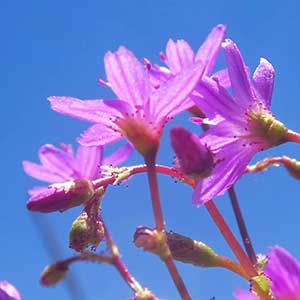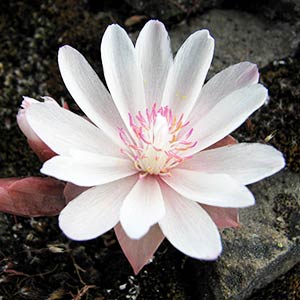Lewisia leeana
Lewisia rediviva
many flower lewisia, quill-leaf lewisia
bitter root, bitterroot lewisia, resurrection flower
gradually ramified distally.
gradually ramified distally.
spreading or suberect, 8–20 cm.
procumbent to erect, 1–3 cm.
basal leaves evergreen, sessile, blade linear, ± terete, 1.5–6 cm, margins entire, apex obtuse;
cauline leaves alternate, intergrading with bracts, blade narrowly lanceolate, 5 mm, margins entire, apex acute.
basal leaves withering at or soon after anthesis, sessile, blade linear to clavate, subterete or grooved adaxially, 0.5–5 cm, margins entire, apex obtuse to subacute;
cauline leaves absent.
paniculate cymes, 50–70(–100)-flowered;
bracts several, alternate proximally, 2 at each flowering node distally, ovate to narrowly lanceolate, 2–5 mm, margins glandular-toothed, apex acute.
with flowers borne singly;
bracts 4–7(–8), whorled, subulate to linear-lanceolate, 4–10 mm, margins entire, apex acuminate.
pedicellate, not disarticulate in fruit;
sepals 2, suborbiculate, 1–4 mm, herbaceous at anthesis, margins glandular-toothed, apex truncate;
petals 5–8, magenta, lavender, or white with or without magenta veins, obovate, 5–7 mm;
stamens 4–8;
stigmas 2;
pedicel 3–15 mm.
pedicellate, disarticulate in fruit;
sepals (4–)6–9, broadly elliptic to ovate, 10–25 mm, scarious after anthesis, margins entire to somewhat erose, apex obtuse to rounded;
petals 10–19, usually rose to pink, sometimes lavender, sometimes with paler or white centers, or wholly white, elliptic, oblong, or narrowly oblanceolate, 15–35 mm;
stamens 20–50;
stigmas 4–9;
pedicel (1–)3–15(–30) mm.
4–5 mm.
5–6 mm.
1–2, 2–2.5 mm, shiny, smooth.
6–25, 2–2.5 mm, shiny, minutely papillate.
= 14.
= 26, 28.
Lewisia leeana
Lewisia rediviva
Lewisia leeana is known only from northwestern California and southwesternmost Oregon, and a disjunct population in Fresno County, California. As discussed by B. Mathew (1989b), Lewisia ×whiteae Purdy (California) is a natural, constantly recurring hybrid between L. leeana and L. cotyledon. In their narrowly spatulate leaves, the hybrids resemble L. columbiana out of range (cf. L. T. Dempster 1993); the flowers are reportedly more deeply colored.
(Discussion copyrighted by Flora of North America; reprinted with permission.)
Varieties 2 (2 in the flora).
Native Americans commonly ate the boiled roots of Lewisia rediviva.
(Discussion copyrighted by Flora of North America; reprinted with permission.)
1. Basal leaf blades clavate to narrowly oblanceolate, grooved adaxially; sepals 10-12(-15) mm; petals 15mm; stamens 20-30 | var. minor |
1. Basal leaf blades linear, subterete, not grooved adaxially; sepals 15-25 mm; petals 18-35 mm; stamens 30-50 | var. rediviva |
- Local floras:
BC,
CA,
OR,
WA
- Local Web sites:
CalFlora,
CalPhotos,
Flora NW,
PNW Herbaria,
Turner Photog.
WildflowerSearch
iNaturalist (observations)
USDA Plants Database
- LBJ Wildflower Center
- SEINet
- Plants of the World Online
- Encyclopedia of Life
- Wikipedia
- Google Image Search



